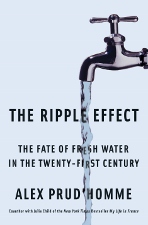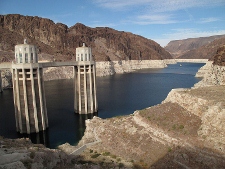Cool, Clear and Increasingly Scarce…
Author: Alex Prud’homme
We need a lot of it for everything. From the straightforward, like growing lettuce and taking showers to the less obvious, like mining natural gas and making computer chips, humans require vast amounts of fresh water for most of the things we do. As our population continues to grow and modernize, we’re going to need increasing amounts in the future. Moreover, we all think we have the right to use as much as we want. But, the reality is that there’s only so much  fresh water to go around and eventually demand is going to outstrip supply – it already has in some places. In The Ripple Effect, journalist Alex Prud’homme explores the past, present and future of life’s most essential ingredient.
fresh water to go around and eventually demand is going to outstrip supply – it already has in some places. In The Ripple Effect, journalist Alex Prud’homme explores the past, present and future of life’s most essential ingredient.
The story starts near the author’s backyard on Newtown Creek, which makes up part of the border between Brooklyn and Queens and is the site of some of the nastiest industrial pollution in the US. He goes on to discuss other examples of water pollution like the Cuyahoga River and Love Canal and how these atrocities led to legislation that has cleaned up some of the many sites like them and the challenges faced in successfully restoring the places that are still toxic. Prud’homme then goes into quite a bit of detail, describing how municipalities go about making sure that our residential tap water is safe to drink. In some locations – where water is scarce – they’ve had to adopt an unavoidably disturbing “toilet to tap” approach, that is certain to become more common in the future.
Following the section on water quality, the author discusses the extremes with extensive sections on drought and flood and the battles that play out every day to try and find a happy balance between the two. He visits the American West, where burgeoning desert populations in Southern California, Las Vegas and Phoenix are inexorably outstripping any and all water sources. He also visits the Netherlands and the engineering marvels that allow this country to stay dry despite the fact that much of it is below sea level. Returning to the US, Prud’homme notes how much work remains to be done to adequately protect cities like New Orleans and New York City from the next big hurricane. While the Dutch recognize the wisdom and cost effectiveness of flood prevention, Uncle Sam is still trying to get his galoshes on.
In the last section, the author explores the future of fresh water in the 21stcentury. As development advances, competing water uses are increasingly coming
into conflict. In Bristol Bay, off the southwest Alaskan coast, battles rage over incompatible water use, pitting the salmon fisheries against the mineral, oil and natural gas industries. Since the national and state governments provide no decision making framework, the courts become the battleground, often resulting in decisions that make no sense and only favor whoever hires the better attorneys.
Prud’homme is a fine journalist and he deftly handles this massive, important and complicated topic, but his ironically dry writing style made the read rather slow going at times. He provides loads of information and I found most of it quite interesting, but he does get overly wonkish at times. Despite this tendency, the book is still enjoyable and he provides a convincing argument that water will eventually eclipse oil as the most economically important natural resource.
In the end, The Ripple Effect is a compelling exploration of the future of water. Who gets to have access? How much do they get? What can they do with it? How much should they pay for it? Who’s going to clean it up when they’re done with it? As clean fresh water becomes increasingly scarce, these questions are becoming more and more difficult to answer and each answer is likely to affect each of us in many important ways. There’s simply no substitute for it.
— D. Driftless
- Best Non-Fiction of 2016 - February 1, 2017
- Little Free Library Series — Savannah - May 22, 2015
- Little Free Library Series — Wyoming - November 30, 2014




Leave A Comment